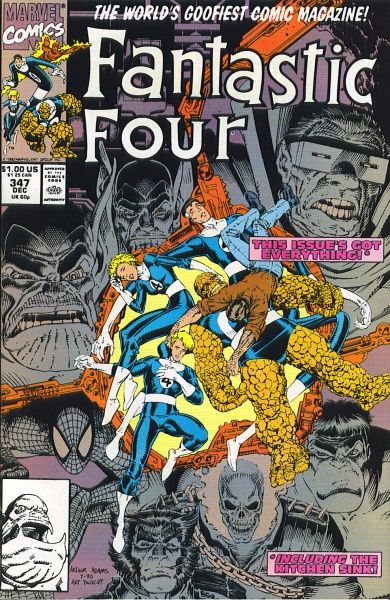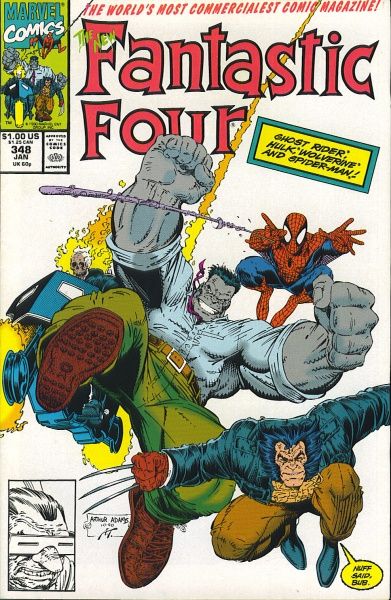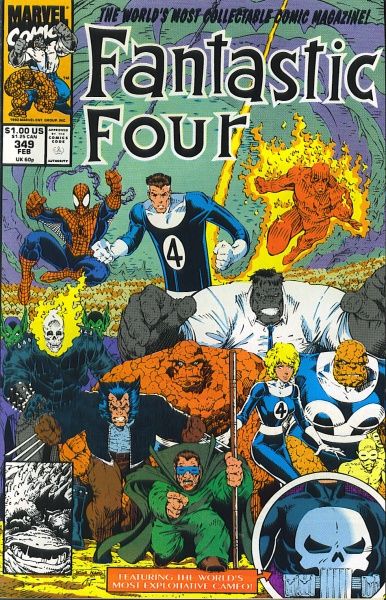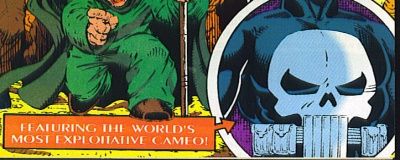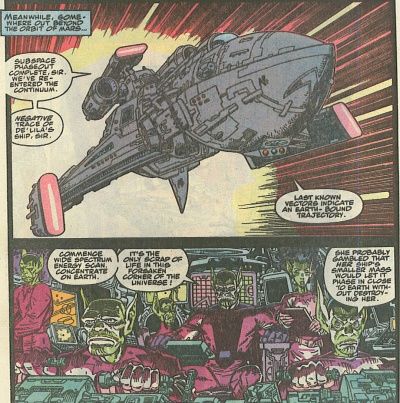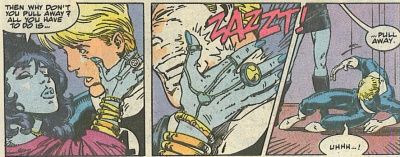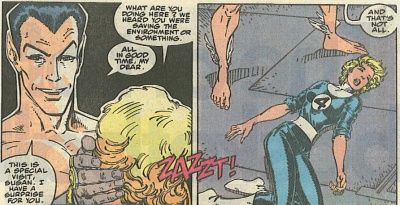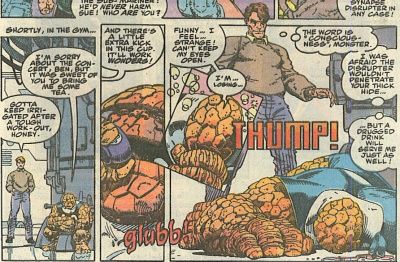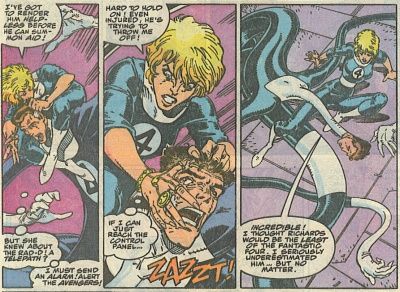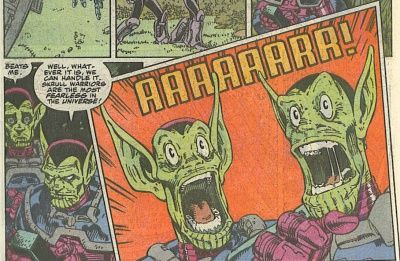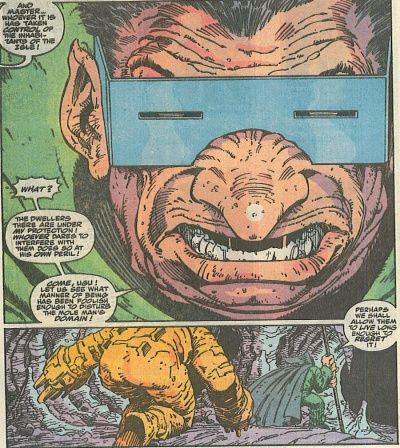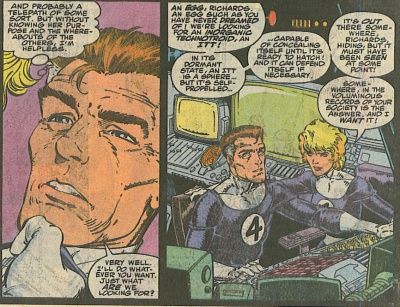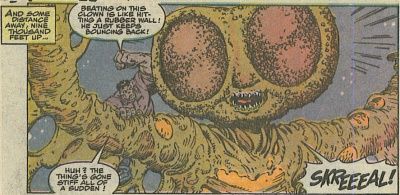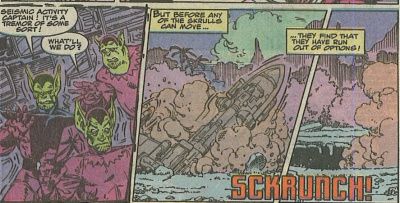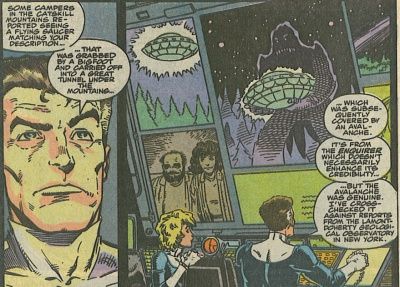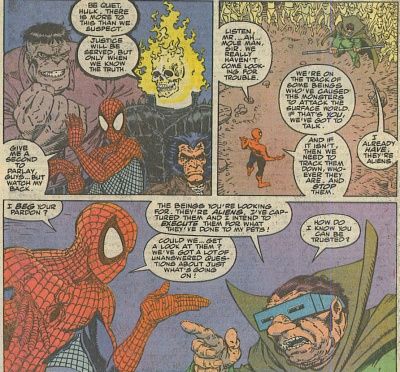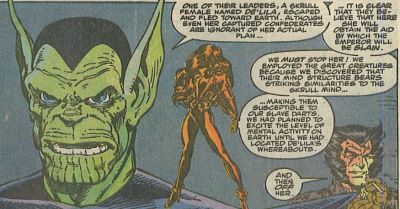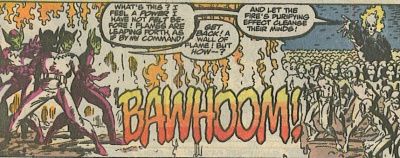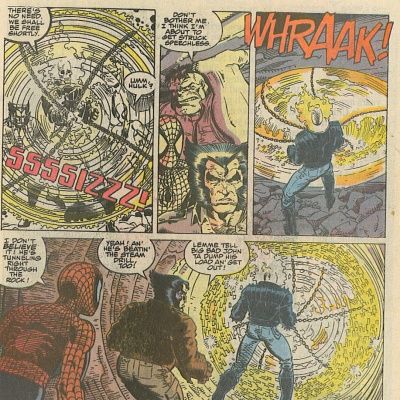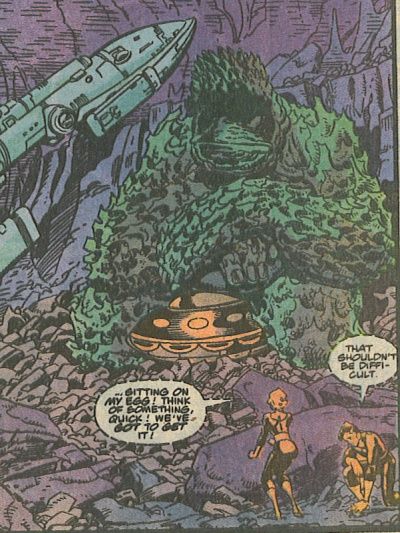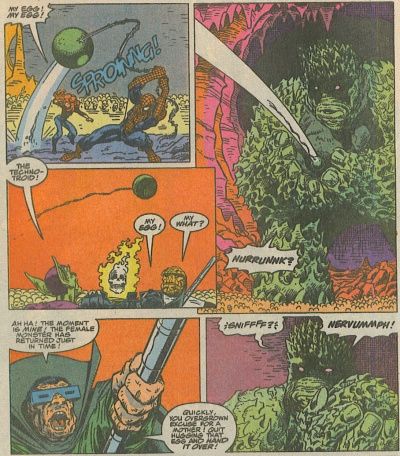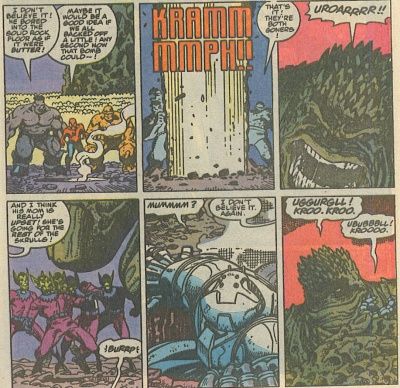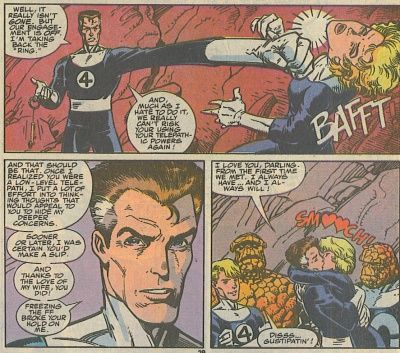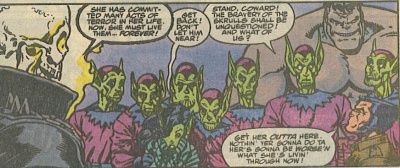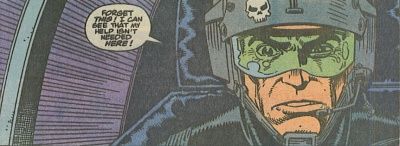Why those issues, you might ask? Why indeed ...
Oh, I suppose I SPOIL these issues. But it's not like they're all that mysterious!
Fantastic Four by Walter Simonson (writer), Arthur Adams (penciller; with "pencilling assistant" Gracine Tanaka), Art Thibert and Al Milgrom (inkers).
Marvel, 3 issues (#347-349), cover dated December 1990-February 1991.
I don't want you to get the idea that all Comics You Should Own are deathly serious affairs because that's what "real" comics are all about. There is, and should be, room for frivolity in comics, and when it's done as pitch-perfect as these three issues, it's just something to be admired.
These comics come from the tail end of a time when Marvel actually made fun of itself. Very rarely do they allow that anymore (Slott's She-Hulk comes to mind, but even that mocks the conventions of comic books more than the company itself), and it's a bit sad. Whereas some older comics fans are nostalgic for the 1970s, I'm nostalgic for the late 1980s/early 1990s, before the market blew up and Image took over and comics lost their sense of humor. Fantastic Four, which sold poorly in 1990 compared to many points during its history, was still the flagship title of the company and recalled the Marvel Age of Comics, and the fact thatSimonson shamelessly mocked the hand that fed himin it reminds us of a time when comics from the Big Two still had a less sophisticated feel to them, instead of today, where everything is geared toward the next movie promotion. I would love to see Marvel do something like these issues today, but there's not enough time for distractions like this when they're too busy dealing with "real world" issues.
But, you ask, isn't this a ridiculous comic book in which the "hot" characters in the Marvel Universe circa 1990 - Spider-Man, Wolverine, Ghost Rider, and the Hulk - supplant the Fantastic Four? Doesn't that make it a crass marketing technique? Well, of course it does, but unlike these days, when Marvel uses Wolverine to "react" to Captain America's death in a completely artificial "event" book, in these comics the company acknowledges the pandering to the utmost. As they point out on the covers:
Plus, on the cover of issue #349, they throw in:
This kind of nuttiness makes these issues a complete joy to read, because we recognize that Marvel is cashing in, but at least it's a fun story to read. If you're going to shamelessly exploit your top moneymakers, at least you get Simonson to write a slam-bang action adventure book and get Adams to draw it. Adams does far too little comics work these days, so going back and looking at the work he has done is all we get. He has a blast with Simonson's tale, as well, drawing malicious Skrulls, monsters, superheroes, the "Joe Fixit" Hulk, and the Mole Man with a kind of crazed abandon. His women are beautiful without being skanky, his men are muscular without being steroided, his Skrulls are goofy yet still threatening, and his monsters are straight out of a 1950s sci-fi movie. Simonson throws plenty at him to draw, but he does it all with flair. It's a shame to consider how very little output Adams has done over his career.
The story is somewhat convoluted, but it has to be in order for Simonson to get the four characters together to replace the FF. So what's the story? Well, I'll let Simonson's words and Adams' art explain ...
A Skrull lands on Earth and plots trouble:
There is the usual situational drama that afflicts superhero teams: Johnny Storm can't get Nebula out of his mind, even though he's married to Alicia, while Ben's girlfriend, Shary, is distraught about becoming the Thing again. This is not your father's Fantastic Four, apparently, and these subplots mean very little for the purposes of this story.
The Skrulls track their prey:
The female Skrull takes out the entire Fantastic Four in the space of five pages, thanks to her shape-shifting abilities and a "synapse disruptor":
The Skrulls land on Monster Island and find, well, monsters:
The Skrulls implant neural disruptors in the monsters to rile them up, hoping their activity will "increase the mental stress level across the planet" so they can track the Skrull fugitive. The Mole Man does not like this:
The female Skrull, whose name is De'lila, lures the replacement heroes to Four Freedoms Plaza and tells them, in the guise of Sue Storm, that the FF have been killed. She gives them a "sub-photonic spectro-analyzer" to find the assassins. After sending them on their way, she reveals that she's looking for a Skrull ship that crash landed on Earth, but she'll have to revive Reed to find it. The Mole Man, meanwhile, discovers that the people stirring up his monsters are aliens. When Reed wakes up, De'lila tells him she's looking for ... an egg. No, seriously:
The new FF fights monsters:
The Mole Man captures the Skrulls:
Reed discovers the crash site, and he and De'lila fly deep underground:
The new FF enters the Bermuda Triangle, flies into the hole down which the Skrulls fell on Monster Island, and encounters the Mole Man:
Ghost Rider drags the reason why the Skrulls are there out of their captain:
Just then Reed shows up, but he's not in the mood to argue, as he's under De'lila's mind control. De'lila uses her telepathy to influence the heroes and the Mole Man, who turn against the Skrulls, but she can't sway Ghost Rider, who, well, manages to clear their minds, but he's not sure how:
Reed and De'lila escape, but the new FF goes after them. They get trapped under a cave-in, but Hulk holds up the ceiling while they figure out how to escape. De'lila continues to use her mind control powers to keep Reed in thrall, and after doing some smooching with him, she tells him about the Inorganic Techno-Troids, whichare "a series of indestructible, synthetic entities, so powerful that only the empress can control them." She plans to use the one inside the egg to "shake the empire." Back in the tunnel, Ghost Rider again saves the day:
In New York, Franklin discovers the Fantastic Four, tied up in the elevator, and frees them all. They discover that Reed went to Monster Island, so they head on out. Back on the island, Reed and De'lila find the spaceship, but a monster has claimed it:
The new FF show up, but De'lila holds Reed hostage so that they have to help her retrieve the egg. They get it out, but the Hulk stops De'lila from taking it. Then the Mole Man shows up, saying that he's taking the egg. As a fight appears imminent, the real Fantastic Four shows up. As they confront each other, De'lila sneaks toward the egg, but Spider-Man stops her. He webs the egg out of her reach, right to ... the monster who was sitting on it. She has decided that the egg is her baby, and defies the Mole Man, who orders her to give it to him:
The monster's mate shows up and plans to attack everyone, but the Skrull captain triggers a bomb so that everything explodes. He explains the the Inorganic Techno-Troids are the ultimate bodyguards. They imprint on the empress at birth and live to serve only her. Because they are so unstoppable, he must obliberate everything. As the bomb counts down, the egg hatches, and the Techno-Troid imprints on ... the monster. De'lila is distraught over this tragedy, naturally. The monster tells the Techno-Troid about the bomb, and the new baby saves the day:
De'lila uses her mind control powers to attempt to flee by lip-locking with Reed again (right in front of Sue!), but Reed is no longer under her control, and he does it just to get her synapse disruptor away from her. Reed's love for Sue saves the day!
Ghost Rider makes De'lila confront her crimes, which isn't pleasant, and Spider-Man convinces the Mole Man to let them go. There's a funny Punisher cameo, and everyone goes home happy. Well, except for De'lila:
I have spent so much time on the plot because this is a wonderful example of throwing everything at the wall and seeing what sticks. Simonson isn't concerned with deep meaning or important themes, he's just interested in entertainment, and he achieves it magnificently. These three issues are never going to show up on a list of greatest comics ever. They are Comics You Should Own, however, because they show how glorious Marvel comics once were and only appear to be very sporadically today.
Simonson, interestingly, also has a handle on the Fantastic Four, which is why this story is a bit above just sheer entertainment (not that there's anything wrong with that). Reed, as noted, holds onto the love of his wife in order to resist De'lila's mind control. Early on in the book, Ben and Shary have a nice moment, even though the circumstances of the situation are unknown. (Of course they're not unknown, because the fact that Ben is human and Shary is back to being the Thing are covered in earlier issues. I'm speaking as someone who didn't read the comic book and picked these up because I was a fan of Adams' work. In issue #349 Ben shows up as the Thing, so the transformation was voluntary, I assume. But that's a back story for another day!) Reed uses a colloquialism ("tell that to all my friends in the Marines") to Roberta, the FF's robot receptionist, that allows her to realize that what he's saying is untrue, so she wakes Franklin to rescue the FF. (That's an actual colloquialism, apparently, although why the hell Reed would know it is beyond me.) All of these little touches show us, more than past and future writers of the comic who state it loudly and proudly, that the Fantastic Four are a family who can rely on each other. It's these nice touches in an otherwise wacky adventure that make this something more than just a cheap marketing ploy.
Despite the tackiness of appealing to the nu-skool fanboys who drooled over the Next Big Thing back in the late 1980s and early 1990s, Simonson and Adams (and Marvel) created a nice comic book with this adventure. It uses the present "hotness" of the characters, but it also remains deeply rooted in Marvel history, but not in a way that completely loses the new reader. Simonson and Adams did not create a masterpiece, but they did create a gloriously fun comic thatcontains almost everything you could want in a superhero book. If Fantastic Four #347-349 isn't an epic story delving deep into the soul of humanity, it is the kind of book we don't get too often these days, especially from the Big Two. We get glimpses of this kind of story now and then, and it's nice to look back at one that did it supremely well.
I can't say if this has been collected in trade, but I seriously doubt it. It's can't possibly be difficult to find or cost too much, and although it's probably not worth it to pay more than 6-7 dollars for these three issues, for that much you get a very fun comic with gorgeous art and a definite old-school feel. There's nothing wrong with frivolity once in a while!


